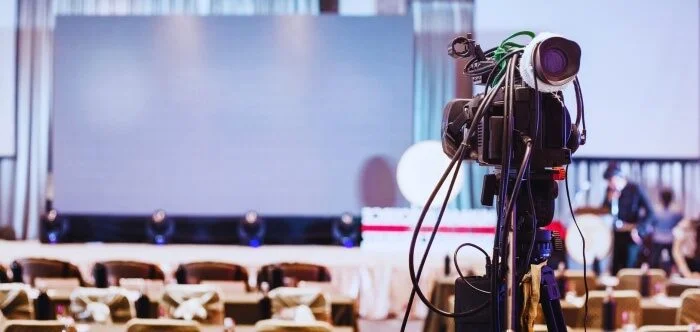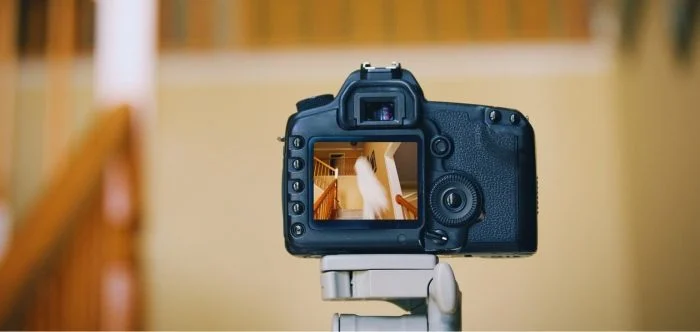Capturing the essence of a conference through photography is both an art and a science. “How to photograph a conference?” is a question that plagues many photographers, both amateur and professional.
It’s not just about snapping random shots; it requires the right equipment, a keen eye for key moments and speakers, and a stealthy approach to maintain discretion. Engaging with attendees and ensuring the lighting complements your subject are equally crucial.
Understanding the specific needs and objectives set by event organizers is fundamental to delivering compelling photographic narratives. In this article, we’ll delve into these aspects, providing you with practical tips to excel in conference photography. Keep reading to discover how to turn ordinary conference moments into extraordinary photographic memories.
What Is the Importance of Capturing Photographs at a Conference?
Capturing photographs at a conference is important because it helps document the event. These images serve as a visual record of key moments, presentations, and interactions that take place during the conference. This documentation is valuable for future reference.

Photographs also increase engagement. They can be shared on social media and marketing materials, attracting more attendees to future events. Eye-catching images draw attention and create interest, helping to promote the conference’s goals and outcomes effectively.
Additionally, conference photographs build connection and community. They capture the networking opportunities between attendees, showcasing the collaborative spirit of the event. These images help attendees relive their experiences and, when combined with options to record a video conference, strengthen their connections long after the conference ends.
Types of Photographs You Can Take at a Conference
Capturing the dynamic essence of a conference requires a diverse photographic approach. Each type of photograph taken serves as a unique piece of the event’s narrative. Here we explore the various types of photographs that can effectively document the multifaceted nature of conferences:
Keynote Speeches
Photographs of keynote speeches are pivotal, encapsulating the event’s intellectual core. These shots should focus on speakers, emphasizing their expressions and engagement with the audience. Capturing the speaker in action, with the audience’s reaction in the background, adds depth to the image.
Panel Discussions
Images of panel discussions highlight the collaborative spirit of the conference. These should showcase the interaction among panelists and their connection with attendees. Aim to capture the diversity of perspectives and the lively exchange of ideas.
Networking Moments
Candid shots of networking moments reveal the conference’s social dynamics. These photographs should capture attendees in discussions, exchanging business cards, or in thoughtful conversation. Such images are invaluable in showcasing the event’s networking opportunities and attendee engagement.
Workshops and Breakout Sessions
Focusing on workshops and breakout sessions, these photos depict hands-on learning and interaction. Aim to capture the concentration, collaboration, and hands-on activities that characterize these sessions. These images reflect the practical, interactive side of the conference.
Venue and Atmosphere
Photographs of the venue and overall atmosphere set the scene for the conference. Wide-angle shots of the conference hall, detailed images of the décor, or photos capturing the ambiance are essential. They provide a sense of scale and context for the event.
A well-rounded conference photography portfolio should include a blend of these types. Each type plays a crucial role in portraying the conference’s narrative, from intellectual discourse to social interactions. Remember, the aim is to weave a visual story that resonates with the essence of the conference.
How to Photograph a Conference?
Photographing a conference is an art that requires meticulous planning and execution. This guide aims to walk you through the key steps to capture the essence of any conference effectively. Each step is crucial in ensuring that your photographs tell the story of the event compellingly.
Step 1: Understanding the Brief
Before the conference starts, it’s important to have a discussion with the event organizers. Ask about their specific goals and the key moments they want captured. Understanding their expectations and any restrictions helps you create a focused photography plan.
Step 2: Choosing the Right Equipment
Selecting the right equipment is essential for capturing quality images. Bring various lenses for different types of shots, such as wide-angle for group photos and zoom for close-ups. Incorporating effective conference photography techniques can also enhance your ability to adapt to different situations. Don’t forget extra batteries and memory cards to avoid running out during the event.
Step 3: Exploring the Venue
Visit the venue before the conference to familiarize yourself with the layout. Identify the best locations for capturing important moments while considering lighting and background. Knowing the venue allows you to plan your shots and helps ensure well-composed photographs.
Step 4: Capturing Keynote Speakers
When photographing keynote speakers, focus on their expressions and how the audience reacts. Use a mix of wide shots to capture the atmosphere and close-ups to show the speaker’s emotions. This variety helps to tell a compelling story about their presentation.
Step 5: Documenting Panels and Workshops
During panel discussions and workshops, aim to capture the interactions between participants. Look for moments of engagement and concentration, as these reflect the collaborative spirit of the sessions. These images help showcase the educational value of the conference.
Step 6: Networking and Candid Moments
Stay alert for spontaneous interactions and candid moments among attendees. These unplanned shots often tell relatable stories about the conference experience. Capturing these moments adds depth to your portfolio, highlighting the personal connections made during the event.
Step 7: Post-Processing and Delivery
After the conference, review your photographs and select the best ones for editing. Make sure the final images align with the client’s brief and tell a clear story about the event. Timely delivery of the edited photos shows professionalism and respect for the client’s needs.
Photographing a conference successfully is about preparation, adaptability, and a keen eye for detail. Each step in this guide is designed to help you capture the multifaceted nature of conferences, creating a memorable and comprehensive visual record. Remember, your photographs are more than just images; they are stories of moments and experiences.
Considerations While Taking Photographs at a Conference
Taking photographs at a conference goes beyond just capturing pictures; it’s about capturing moments that reflect the event’s spirit. To achieve this, there are important factors to consider. These factors help ensure that the photos truly represent the environment and significance of the conference.
Understanding the Agenda
Familiarizing yourself with the conference agenda is essential for capturing key moments. By knowing the schedule, you can anticipate important sessions and activities, allowing you to position yourself effectively to document significant interactions and highlights throughout the event.
Respecting Privacy and Permissions
It is important to respect the privacy of attendees and speakers when taking photographs. Some individuals may have specific restrictions regarding being photographed. Always seek permission when necessary to ensure everyone feels comfortable and respected during the event.
Lighting and Composition
Analyzing the lighting in various areas of the venue is crucial for achieving clear and impactful photographs. Good lighting increases the overall quality of your images. Pay attention to natural light sources and consider using additional equipment when necessary to improve your shots.
Capturing a Variety of Shots
Including a diverse range of shots in your photography is important for providing a detailed representation of the conference. Combine close-ups, wide-angle views, and candid moments to showcase the event’s atmosphere and highlight different aspects of the gathering.
Minimizing Disruption
While photographing the conference, aim to move around discreetly. Avoid disrupting speakers or attendees to maintain the event’s flow. Your presence should be unobtrusive, allowing everyone to focus on the presentations and discussions without distraction.
Post-Event Editing
Planning for post-event editing is essential to enhance and refine your photographs. Selective editing can significantly improve the quality of your images, helping to adjust colors, brightness, and contrast. This process ensures your final photos effectively capture the essence of the conference.
Photographing a conference requires more than technical skills; it needs planning and an understanding of the event’s atmosphere. By keeping this in mind, you can take respectful, visually appealing photos that enhance the experience for everyone involved.
Essential Tips to Take Professional-Level Photographs of a Conference
Photographing a conference professionally demands more than just capturing images; it’s about telling the story of the event through your lens. To achieve this, a photographer must balance technical skills with an understanding of the event’s context. Here are a few essential tips that will elevate your conference photography to a professional level:
- Arrive Early: Getting to the venue before the conference starts allows you to set up your equipment and familiarize yourself with the environment, ensuring you are ready to capture important moments right from the beginning.
- Engage with Attendees: Building rapport with attendees can lead to more genuine and candid shots. Engage in conversations, which will make them feel comfortable and relaxed in front of your camera.
- Stay Active: Move around the venue during the event to capture a variety of perspectives. Being active and mobile helps you find unique angles and moments that might be missed if you stay in one spot.
- Focus on Details: Don’t forget to capture the little things that contribute to the conference atmosphere. Close-up shots of name tags, programs, and decorations can add depth and context to your photo collection.
- Observe the Flow of the Event: Keep an eye on how the event progresses. Understanding the timing of speeches, breaks, and networking opportunities will help you anticipate great moments to photograph.
- Use Natural Light When Possible: Take advantage of natural light to enhance your photographs. Position yourself near windows or open areas to achieve softer lighting that makes your images more appealing and vibrant.
- Review Your Shots Throughout the Day: Periodically check the images you’ve taken to ensure they meet your standards. This helps you identify any adjustments needed in your technique or settings before moving on to the next session.
Professional conference photography combines technical skills, strategic planning, and storytelling. By following these tips, you can authentically and compellingly capture the essence of the conference. Ensure you understand effective camera settings for conference coverage to improve your results, making your photographs present the event’s atmosphere and significance.
Frequently Asked Questions
Photographing a conference effectively requires a mix of planning, technique, and understanding of the event’s dynamics. Below are some frequently asked questions that provide insights and tips for capturing memorable moments during a conference.
What Should I Do Before the Conference Starts?
Before the conference begins, it’s crucial to communicate with the event organizers to understand their expectations and objectives. This discussion will help you identify key moments to capture and any specific guidelines to follow, ensuring you are well-prepared for the event.
How Can I Ensure I Capture Key Moments?
To capture key moments during the conference, familiarize yourself with the agenda and schedule of activities. Being aware of important sessions and speakers allows you to position yourself strategically, ensuring you’re in the right place at the right time to document significant interactions.
What Techniques Can Enhance My Conference Photography?
Using a variety of photography techniques can enhance your conference images. Experiment with different angles, focal lengths, and compositions. Incorporating candid shots, detailed close-ups, and wide-angle views will provide a detailed visual narrative that captures the essence of the event.
How Should I Handle Lighting Situations?
Lighting can greatly impact your photographs. Always assess the lighting conditions in the venue and utilize natural light whenever possible. If the lighting is poor, consider using external flash or reflectors to ensure your images are clear and vibrant, maintaining quality in every shot.
What Is the Importance of Post-Processing My Photos?
Post-processing is essential for refining your photographs after the conference. Editing allows you to adjust elements like brightness, contrast, and color balance, enhancing the overall quality of your images. This final touch ensures your photos effectively present the atmosphere and significance of the event.
Bottom Lines
Mastering the art of conference photography requires careful planning, technical skills, and an understanding of the event’s dynamics. By following the tips outlined throughout this guide, you can effectively capture the essence of any conference. Ultimately, the key to answering “how to photograph a conference?” lies in preparation, engagement, and adaptability to various situations.
As you start on your photography process, remember to arrive early, engage with attendees, and make the most of the natural light available. These strategies will help you create engaging images that tell the story of the event. Best wishes as you capture remarkable moments that reflect the spirit of the conferences you attend!





